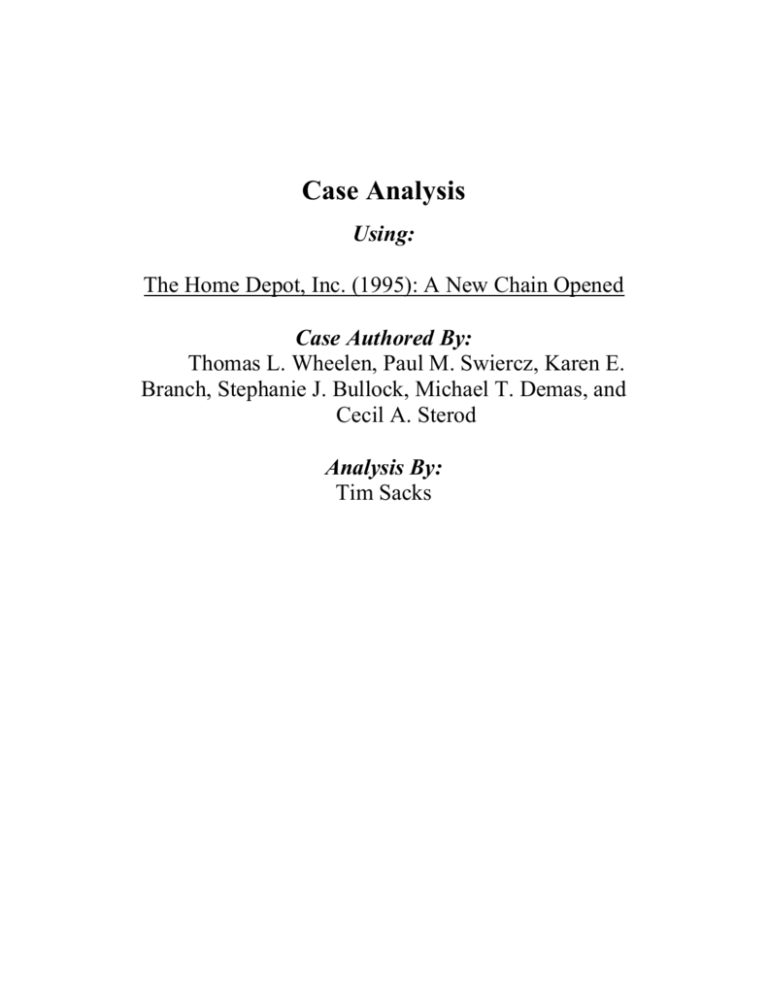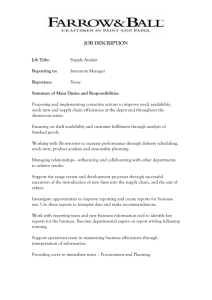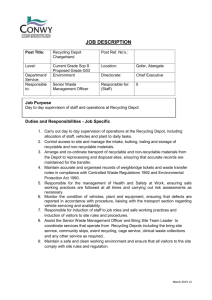Corporate Level Strategy
advertisement

Case Analysis Using: The Home Depot, Inc. (1995): A New Chain Opened Case Authored By: Thomas L. Wheelen, Paul M. Swiercz, Karen E. Branch, Stephanie J. Bullock, Michael T. Demas, and Cecil A. Sterod Analysis By: Tim Sacks Corporate Level Strategy The Home Depot integrates a dynamic corporate level strategy commensurate to its ability to sustain rapid expansion. Since inception in 1978, The Home Depot has enjoyed a 30% average annual growth rate. Their phenomenal growth rate is a partial product of their corporate level strategy. The Home Depot has primarily used a Growth / Concentration / Horizontal strategy to achieve unprecedented growth. The firm focuses on expanding their products into multiple geographic locations at the same point in their value chain, while simultaneously increasing the range of products and services offered to current markets. For example, as the company penetrated markets throughout the U. S. Sunbelt, they experimented with enlarging their store’s garden centers and initiated an “Expo Design Center” storefront. The expo centers are a geographic market niche, targeting upscale homeowners by utilizing computer-aided design technology (CAD) and offering top-of-the-line major kitchen appliances. Occasionally, the corporate strategy follows a Stability / Short-term / Pause strategy to digest their rapid growth. From 1978 to 1983, The Home Depot grew from an idea to a nationally recognized leader in the do-it-yourself industry. Home Depot’s CEO Bernard Marcus believed the only restraint The Home Depot faced was its inability to quickly recruit and train new staff. The rapid expansion into the unknown territories of Houston and Detroit took management’s attention away from the other stores and their earning dropped 40% in 1985. For a brief period in 1986, The Home Depot followed a geographically oriented Retrenchment / Survive / Divestment strategy in Detroit, Michigan. They withdrew from Detroit, by selling off their five brand new stores. After regrouping in 1987, The Home Depot returned to a horizontal growth strategy by opening six California and two Tennessee stores. Organizational Structure The Home Depot’s multidivisional organizational structure is collaborative with its current corporate structure. Advantages of the multidivisional structure include: emphasis of rapid growth, augmented facilitates management development and training, utilization of decentralized decision making, enhancements towards profit and loss responsibility and overall accountability. This system is more costly than other organizational structures, but The Home Depot’s rapid growth and increasing profits warrant the added expense. The Home Depot Management is layered so there are both vertical and horizontal linkages among the firm’s management. The bottom of the structure consists of store department managers governed by one store manager responsible for delegating duties and upper management’s directives. The store manager reports to a regional manager with connections to all the firms functional departments. The functional departments include information services, legal matters, advertising and merchandise accounting along with many other core functional departments. The functional departments are positioned on the organizational structure so that they are accessible by all of the stores through their regional manager, and positioned below the geographic divisional presidents and upper senior management. All of the operations departments share horizontal linkages facilitating data sharing through implementation of satellite communication systems and advanced computer network systems. Senior Management even has direct linkages to individual stores through their own television network, HDTV. This allows the senior management to receive feedback from local managers and allowed current training and communications programs to be viewed in individual stores. The CEO, Bernard Marcus, emphasizes a relaxed corporate culture, so that every manager felt like they could report to anyone. One advantage of the multidivisional structure is the decentralization of decision making. This is widely used in the corporate cultural of The Home Depot. For example, corporate headquarters set individual stores up so that they were very similar, but individual managers could change a display or order more or less of a product if they could justify the change. Local managers also have the authority to help out in the community. Bernard Marcus believes that this constructs better positive relations with the stores surrounding community. Furthermore, a local store manager is more attune to community needs compared to a corporate vice-president. The decentralization fits well with the firm’s rapid expansion corporate culture, because it places the decision making process closer to the new stores that necessitate quick decisions tailored to their new geographic market environment. International Operations The placement of international operations on The Home Depot’s organization chart reveals that the firm treats international stores similar to those in the U. S. divisions. There are presidents for each geographic division in the U. S., a president for the Canada division and presidents for the Expo and Crossroads divisions. All presidents have direct linkages to each functional division. Home depot created a Vice President for expansion into Mexico, and positioned the office on the same level as the functional divisions. This is because The Home Depot plans a cautious and slow expansion into Mexico, where they will pay special attention to Mexico’s volatile economy and unskilled workforce. The Mexico division is not large enough to warrant a divisional president, but The Home Depot anticipates future success in Mexico, leading to expansion throughout Central and South America. Leadership The Home Depot employs a corporate culture that supports its strategy. The firm uses a cluster strategy to allow for their rapid expansion. This strategy intentionally cannibalizes sales of existing stores in a single market area, but it erects entrance barriers and spreads advertising and distribution costs over a greater store base, thereby passing savings on to the consumer. If a region is unable to digest the cluster theory, The Home Depot will modify their culture to make it compatible with the new strategy. For example, The Home Depot acquired Aikenhead’s Home Improvements Warehouse chain in Canada, and formed a joint venture to insure a smooth transition of corporate cultures in Canada. The Home Depot’s growth strategy is complimented by the corporate belief that an individual can make a difference in the company. Executive Succession The Home Depot typically promotes from within the company. Managers start in local store departments and move up the ranks from there. The organizational structure is linear and breeds individuals that have knowledge learned from the ground up. The Home Depot uses a “staffing follows strategy” approach and promotes managers that fit the relaxed corporate culture environment. They also match managers to strategies. For example, Bell Peña was hired as Vice-President of Mexico because he had extensive Mexican retail experience. The Home Depot should be well prepared if Bernard Marcus, Arthur Blank and / or Ronald Brill left the firm. They are the originators of The Home Depot, but over the firm’s existence they have cultivated a firm with a clear corporate strategy backed by a successful corporate culture. Currently, The Home Depot has long term goals and objectives backed by a prominent executive succession and training program that could implement the goals if the three senior executives left the firm.









